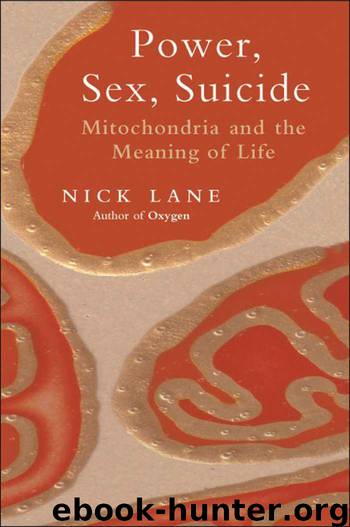Power, Sex, Suicide: Mitochondria and the meaning of life by Lane Nick

Author:Lane, Nick [Lane, Nick]
Language: eng
Format: mobi
Publisher: Oxford University Press
Published: 2005-10-12T16:00:00+00:00
Proton leak
But there is a diabolical catch. We have seen that the muscles contribute little to the resting metabolic rate: the danger of oxygen toxicity means that blood is diverted away from the muscles and into the organs, where there are relatively few mitochondria to cause damage. So what might have happened in the first mammals? They had extra mitochondria in their organs to compensate for their higher aerobic capacity, but nowhere to divert the blood, which had to pass through either the organs or the muscles.
Once our prototype mammal has digested his food, caught so easily with his newfound aerobic prowess, he goes to sleep. Beyond replenishing his reserves of glycogen and fat, there is little call to expend energy. His mitochondria fill up with electrons extracted from food. This is a dangerous situation. The respiratory chains in the mitochondria become packed with electrons, because there is only a sluggish electron flow. At the same time, there is plenty of oxygen around, as the blood flow can’t be diverted. In these conditions, electrons easily escape from the respiratory chains to form reactive free radicals, which can damage the cell. What might be done?
According to Martin Brand in Cambridge, one answer might be to waste energy by keeping the whole system ticking over. The danger from free radicals is at its greatest when there is no electron flow down the chain. Electrons pass most readily on to the next complex in the chain, and so tend to react with oxygen only when that complex is choked up with electrons, blocking normal flow. Restarting electron flow usually requires the consumption of ATP.3 If there is no demand for ATP, the whole system clogs up and becomes reactive. This is the situation when resting after a large meal. One possible escape is to uncouple the proton gradient, so electron flow is not tied to ATP production. In Part 2, we compared this to a hydroelectric dam, in which an overflow channel prevents flooding in times of low demand. In the case of the respiratory chains, instead of passing through the ATPase to generate ATP (the main dam gates), some protons pass back through other pores in the membrane (the overflow channels), so that part of the energy stored in the gradient is dissipated as heat. By uncoupling the proton gradient in this way, slow electron flow is maintained, and this restricts free-radical damage (just as the overflow channel prevents flooding). The fact that such a mechanism does protect against free-radical damage was verified in a fascinating study of mice by John Speakman and his colleagues in Aberdeen, working with Martin Brand. Their title said it all: ‘Uncoupled and surviving: individual mice with high metabolism have greater mitochondrial uncoupling and live longer.’ We’ll look into this further in Part 7, but in short they live longer because they accrue less free-radical damage.
In resting mammals, perhaps a quarter of the proton gradient is dissipated as heat. The same is true of reptiles, but they have barely a fifth the mitochondria in each cell and so generate five times less heat per gram.
Download
This site does not store any files on its server. We only index and link to content provided by other sites. Please contact the content providers to delete copyright contents if any and email us, we'll remove relevant links or contents immediately.
| Cell Biology | Developmental Biology |
| Entomology | Marine Biology |
| Microbiology | Molecular Biology |
| Biostatistics |
Sapiens: A Brief History of Humankind by Yuval Noah Harari(14245)
The Tidewater Tales by John Barth(12608)
Mastermind: How to Think Like Sherlock Holmes by Maria Konnikova(7222)
Do No Harm Stories of Life, Death and Brain Surgery by Henry Marsh(6887)
The Thirst by Nesbo Jo(6826)
Why We Sleep: Unlocking the Power of Sleep and Dreams by Matthew Walker(6618)
Life 3.0: Being Human in the Age of Artificial Intelligence by Tegmark Max(5474)
Sapiens by Yuval Noah Harari(5293)
The Longevity Diet by Valter Longo(5017)
The Body: A Guide for Occupants by Bill Bryson(4973)
The Rules Do Not Apply by Ariel Levy(4842)
The Immortal Life of Henrietta Lacks by Rebecca Skloot(4524)
Animal Frequency by Melissa Alvarez(4394)
Why We Sleep by Matthew Walker(4358)
The Hacking of the American Mind by Robert H. Lustig(4318)
Yoga Anatomy by Kaminoff Leslie(4303)
All Creatures Great and Small by James Herriot(4230)
Double Down (Diary of a Wimpy Kid Book 11) by Jeff Kinney(4204)
Barron's AP Biology by Goldberg M.S. Deborah T(4095)
